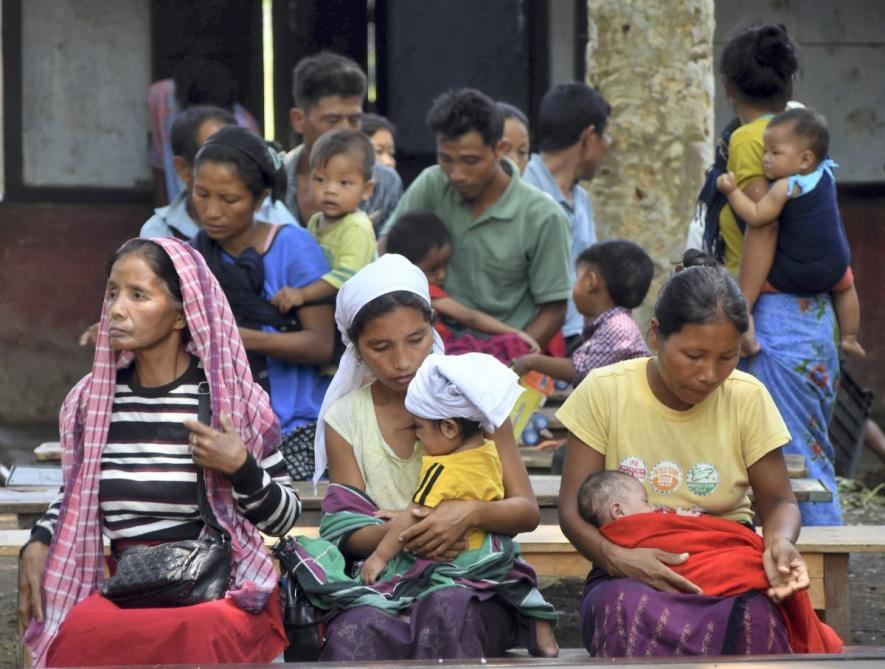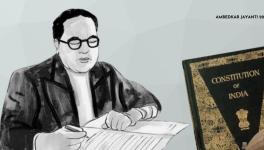Manipur: As Fault Lines Widen, Kuki MLAs Demand Separate Administration

People from the violence-hit areas of Manipur at a relief camp set up by the Assam government, in Cachar district of Assam. Image Courtesy: PTI
The air of Manipur is filled with dissonance, mistrust and a feeling of serious insecurity for the future. With the recent violence, people had to flee from where they had been living for years—Kukis left the valley and went to the hills, and similarly, Meitei emptied their spaces in the hills and came down to the valley.
There is a perturbing uncertainty about whether these people will be able to return to where they lived. Internet services are suspended throughout the state, and military and paramilitary forces control the situation. The curfews are in place; however, it could be relaxed from the evening for the last two days.
But the concerns that fill up the hearts of everyone are how far tenable the 'forced normalcy' is, whether people will be able to continue their lives ever as they were before, and will the hatred among communities slackened in the near future.
Amidst such a situation, a demand for a separate administration for the Kuki-dominated districts has been raised by 10 MLAs of the state, out of which seven are from the ruling party BJP (Bharatiya Janata Party).
Manipur, at this moment, is a contentious space. Each group has its own story and perspective on the faultlines existing through history and, very obviously, divided opinion over the latest demand for separate administration. However divided the narratives are, in the end, what the world witnesses are the colossal loss of properties, the breaking of the harmony and turmoil in the lives of many.
IS SEPARATE ADMINISTRATION FOR KUKIS A SOLUTION?
In their recent memorandum submitted to Amit Shah, the 10 Kuki MLAs of Manipur said it has become impossible to resettle in the valley. The tribals have lost their faith in the Manipur government, so the arrangement of a separate administration for Kuki-dominated districts should be made as soon as possible.
The memorandum said, "As you are fully aware, the recent institutionalised ethnic cleansing and atrocities committed by the majority Meitei Community against the ethnic Kuki-Chin-Mizo-Zomi-Hmar minority community has left everyone aghast. That Manipur is now partitioned is the Ground reality. Huge population transfers between the valley and the hills inhabited by the Kuki-Chin-Mizo Zomi-Hmar had occurred. There are no tribals left in the Imphal valley. There are no Meiteis left in the hills. The Government of Manipur and its police machinery were communalised and used in the pogrom against the Kuki tribals. Kuki colonies and houses were marked and attacked precisely in the Imphal city."
The demand, with some serious allegations, has been out rightly rejected by Biren Singh, the CM of Manipur and Shah. The argument is to maintain the integrity of the state of Manipur.
Pradip Phanjoubam is a veteran journalist based in Imphal and the editor of Imphal Review of Arts and Politics.
Speaking to NewsClick, Phanjoubam said, "I don't think this will work. It will be complicated to draw the lines for administrative separation. Moreover, there are conflicts among other tribes as well. Don't we remember the Kuki-Naga clashes in the nineties where thousands died?"
Left parties CPI (Communist Party of India) and CPI(M) (Communist Party of India (Marxist)) are also not favouring the administrative separation.
Kshetrimayum Santa, Manipur state secretary of CPI(M), said that his party opposes the demand as this will further widen the gaps between the communities.
"Rather, the government should be unsure about resetting the Kukis and the Meiteis in their original places. Moreover, there has to be heavy compensation granted by the government for those who have lost their properties in the conflicts."
On the other hand, the demand is seen as a plausible way of safeguarding the tribals.
Sanmuanlian Tonsing, a doctoral fellow at the University of Michigan and a native of the Churachandpur district of Manipur, has a different point to argue in favour of the separate administration demand.
According to Tonsing, even without the administrative separation, the division will continue.
"The division between the dominant Meitei and the tribals is already there, and after the recent violence, this will continue further. The administrative separation will not divide Manipur as such; rather, it will be an instrument for safeguarding the tribals, that too within the provision of the Indian constitution."
Tonsing is more categorical while speaking about the Kukis and how the community has been targeted.
"It has been deliberately said that the conflict is with the Kukis. It is more nuanced to say 'Kuki-Zomi-Hmar' instead. In the present conflicts, the Meiteis are cautiously not mentioning the Nagas; they attacked the Kukis. It is between the Meiteis and the non-Naga tribals."
"Before this happened, we did not know that the Meiteis have this much hatred for us (tribals). The scale of violence against us is unimaginable and is not narratable. Remember, the administrative separation will only ensure the safeguarding of the tribals. It is not against the Meiteis. The Kukis living in the valley for years, either in government or other jobs, will never return to the valley. The course of their lives will be changed hereafter."
Tonsing also pointed to the development disparity between the hills and the valley.
"People come to the valley only because of the confinement of most opportunities here. I accept that the valley has become crowded, and Meiteis want more land. But you will also have to look at the infrastructural development in the valley and the hills. The huge infrastructures in the valley have occupied huge swathes of land and are fast reaching saturation. Some of it could have been extended to the hills as well. Then people would have got opportunities in the hills as well, and land crisis in the valley would have been reduced to an extent."
Thongkholal Haokip, an assistant professor at CSLG (Centre for the Study of Law and Governance), JNU (Jawaharlal Nehru University), told NewsClick that the separate administrative demand would depend on what shape the final agreement takes.
"The separate administration will depend on its character, whether it is the normal 6th schedule, the territorial council or the district council. With the 125th constitutional amendment, territorial councils are being discussed for Dima Hasao, Karbi Anglong in Assam and some parts of Tripura. Then the same provision can also be discussed for Manipur," Haokip said.
On the wide-scaled violence in Manipur this time, Haokip said that a "political machination" has been in place, without which it was impossible.
"It was said that the hill people are engaged in poppy cultivation. There is poppy cultivation, but only 10% of the hill population does this. Moreover, with interventions of civil society groups and intellectuals, it has reduced since last year."
On the issue of illegal immigrants from Myanmar to Manipur hills, Haokip said, "We can only guess about it. And if that had happened, it could have been handled differently, like Mizoram did, providing them identity cards and managing their shelter. They will go back when the situation in Myanmar becomes normal. The influx is due to the Junta in Myanmar. Remember, on the other side of the border as well, they are Kuki people, separated after the international boundaries were drawn."
DID A MEITEI MLA MISINFORM IN A RECENT INTERVIEW?
In a recent interview with Karan Thapar, Nishikant Sapam, a Meitei independent MLA of Manipur who supported the BJP, talked about the population changes in Manipur. He said that the Kuki population back in 1901 was only 1% (this, however, was contested by Thapar during the interview) and tried to portray that the Kuki population has grown exponentially over time, and this, according to him, is due to illegal influx to Manipur.
Haokip provided the data, which he claims to be the actual one and taken from the Census report.
"The population of Kuki was 1% in 1901 in Manipur, according to a Manipur MLA in an interview. According to the 1901 census, Manipur has a total population of 284,488 persons, where 41,262 were Kukis, which is 14.5%. Out of the total population, 20,322 persons were categorised as others. Meiteis were not 64%; they were 57.7%, including Lois population."
"The total population of Kukis in the 2011 Census is 464,893, which is 16.2% of the total population of Manipur, i.e. 2,855,794 persons. In 110 years, their population increased by 1.7% to the total population of the state," Haokip clarified.
The Manipur Kingdom or the Meitei Kingdom witnessed ups and downs that can be traced back from the pre-colonial period till the merger of Manipur with India in 1949. The Manipur kingdom had to suffer from numerous wars with the Burmese, which ended in 1826 with the signing of the "Treaty of Yandaboo".
The kingdom was settled in the valley, and its jurisdiction extended up to the hills where the Maharaja of Manipur could collect tax from the hill tribes. The hills were self-governed by tribal chiefs, as argued by Sangmuan Hanging. Only during the colonial period did the hills and valleys amalgamate into a single administrative unit towards the late 19th century. But, the hills and the valley were governed separately.
The Manipur Kingdom lost its battle with the colonial power in 1891, and the 'rule of the native' was introduced. Here, the governance of the hills and the valley came under the jurisdiction of separate administrative heads. This probably is the seed of conflicts between the hills and the valley, as argued by Veronica Khangchian, a faculty member of ITM University, Gwalior.
Jangkhongam Doungel, a professor at Mizoram University, told Newsclick that Kukis have been in Manipur hills since time immemorial.
“The first Kuki group arrived as early as 1,500 AD. They have different identities like Chin in Myanmar (Burma), Kukis in Assam and Manipur and Mizo in Mizoram. They are also known as Zomi in some places in Manipur and Burma but are collectively known as Zo people,” Doungel said.
“The Zo (Chin-Kuki-Mizo) group inhabited its ancestral land, demarcated by the British as three provinces which emerged in India, Burma and Bangladesh. There was no national and international boundary in the pre-British period. Therefore, the village boundary of Zo people became the national and international boundary. There is no question of their exodus as they move freely in their inhabited areas,” Doungel added.
According to Doungel, the ‘Kuki exodus’ is only a “propaganda campaign of N Biren Singh and his puppet fanatic organisations which are fit to be declared as unlawful. The recent violence was aimed at the ethnic cleansing of Kukis”.
Sarah Hilaly of Rajiv Gandhi University, Arunachal Pradesh, talked about why excluding the valley people from buying lands in the hills is justified.
"Manipur has had two distinct issues within the hill-plain binary and its genealogy since the pre-colonial period. While the hill people (Kukis) tried to protect their respective domains and resources against absorption by the state, they often tried to appropriate valley resources by disrupting settled agriculture, which indicated expanding state power. Simultaneously there existed symbiosis evident from instances which permitted the flow of goods across these hills to the plains. For that, some payment was often made by either valley landlords or states. The Manipuri kings, for example, often took refuge in the hills from successive Burmese invasions or occupations of Manipur. Hence the relationship was not always antagonistic."
Hilaly explains how colonial writers talked about the independence of Kukis from the states of Cachar, Tipperah and Manipur.
"In 1882, DC Cachar J. Edgar alludes to Kukis being independent of the valley states of Cachar, Tipperah and Manipur. In 1878 the 'Inner Line' was extended to Kuki hills from the direction of Cachar and in 1879, from the direction of Chittagong. This line was well defined regarding boundary as cartographic delineation had occurred. All British judicial rules were withdrawn from these spaces under the 'Inner Line' to be governed by simpler laws by the Scheduled District Act of 1874.
The exclusive nature of the areas beyond the Inner Line was retained in the Government of India Acts of 1919 and 1935.
"The Constitution of India uncritically adopted the lineage of these Acts, which continued the protections of the colonial period in the Kuki areas, too, like other hill areas of North East India. In tandem, the forests in these areas are protected too."
Get the latest reports & analysis with people's perspective on Protests, movements & deep analytical videos, discussions of the current affairs in your Telegram app. Subscribe to NewsClick's Telegram channel & get Real-Time updates on stories, as they get published on our website.
























